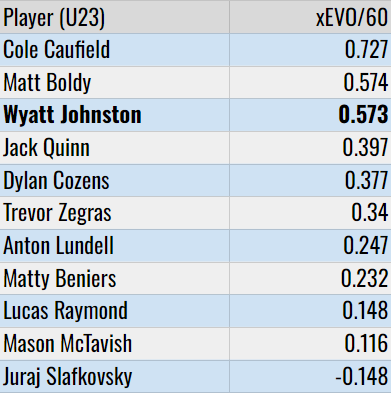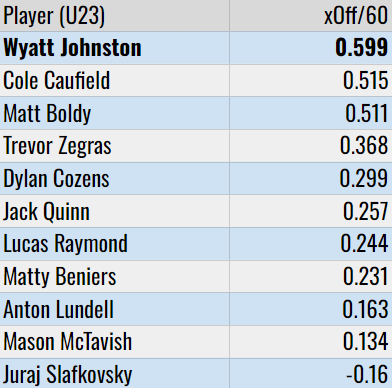Wyatt Johnston is ranked 22nd among hockey's best prospects under 23: A measured response
It's just like...my opinion, man.
I promised myself I was done writing about Wyatt Johnston.
I lied.
Corey Pronman ranked Johnston at #22 among the NHL’s best prospects under 23. Is that fair? Pretty much. But I wouldn’t be here if I agreed in full.
First let me just say that I’m not a draft expert despite pretending to be, and to be honest, there are players below Johnston (like Logan Cooley) that I think are just more talented, and thus should be ranked above him. There are players I’d personally rank above Johnston whose development has been slower, but who I think will end up higher (Quinton Byfield). There are also players whose position makes it impossible to judge, like defenseman Alexander Nikishin (ranked below Johnston at #23) and David Jiricek (ranked above Wyatt at #20). The other important thing to establish upfront is that we’re talking about something relatively subjective.
However, that “something relatively subjective” is about the grand scheme of things. Here and now is a little less subjective. And that’s what brings us to Johnston’s rank. Let’s start by going back to Pronman’s list and filtering out the players I think are obviously better (like Jack Hughes and Tim Stutzle), and the ones I think will obviously be better in time (like Adam Fantilli and Matvei Michkov*). Then let’s focus on the players with real playing time at similar positions that we can assess. From that we end up with the following ranking:
Dylan Cozens
Matty Beniers
Trevor Zegras
Cole Caufield
Matt Boldy
Mason McTavish
Juraj Slafkovsky
Anton Lundell
Wyatt Johnston
Lucas Raymond
Jack Quinn
Leaving aside whatever personal feelings you (or I) have, what would that list looked like if we just judged the forwards on their point rates at even strength?
I’ve mentioned the rule of thumb on these before, but if you forgot here it is: a true top-line forward will give you, on average, 2.5 points per hour or more of even-strength play, while a top-three forward delivers between 2.0 to 2.5 points. Top six? Between 1.5 and 2.0 points. Bottom six? Between 1.0 and 1.5 points.
So far, Pronman’s rank looks completely justified. Johnston ranks like a top six forward, which is excellent for a rookie, but not quite “truly special” territory. What’s worth noting here is that except for Jack Quinn, everyone ranked above Johnston played more minutes per game (and by a decent margin). Granted, this doesn’t necessarily mean more minutes would have meant more points — that’s why we use rates to get a better idea of true production to begin with. But I just wanted to point that out. Despite being ranked more or less where Pronman had him, he’s still higher than three forwards directly above him.
Sidebar: This exercise is a little unfair to Slafkovsky since he played basically fourth line minutes in Montreal. I should have taken him out for that reason but I was too lazy to re-crop my pictures. (My brain tried to justify it by arguing that I really don’t like Slafkovsky’s game, and believe there are huge red flags, but he’ll be bonkers if he puts it all together.)
If Pronman’s list ranked these forwards by the shot quality they generated on their own, how would this list change?
What this argument is saying: Basically that Johnston can be relied upon to generate high danger scoring opportunities all by himself. For one season, he was on a level that Cole Caufield has been at for his entire career. I don’t expect Johnston to be a Caufield-level scorer but that’s pretty damn impressive. Granted, we know that already. (Note to unpaid subscribers: I’ll be unlocking the Johnston video piece next week just as the Thomas Harley one goes up, so be on the look out.)
What this argument is not: Being able to generate shot quality all by yourself is only one type of skill. Beniers and Zegras don’t rate as highly because they were and are heavy-duty facilitators. Plugging my Johnston video analysis above, I believe there’s some playmaking to Johnston’s game. In fact, I would argue it’s completely untapped. The hallmark of any good playmaker is how clever they are, and Johnston is very, very clever. But I don’t believe his playmaking is on Zegras’ level, and whatever Beniers lacks in creativity, he makes up for in being a the plus athlete that Johnston is not.
If Pronman’s list ranked these forwards by their expected goal rates above a replacement-level forward, how would this list change?
Think of Goals Above Replacement kind of like what a player’s goal-scoring ability might look like if all goaltenders were created equal, and equally average.
So far it’s abundantly clear that Johnston has a strong impact on shot quality; so much so that it’s starting to look like Johnston belongs with the absolute best of his class. What what if included his shift-to-shift expected offense at even strength, and on the power play?
Then Johnston’s the best.
However, I want to stress that these are largely just fancy counting stats: points per hour, expected goals per hour, expected goals above replacement per hour, expected goals above replacement at EV and on the PP per hour…all we’re looking at is how well these players produce, and/or can be expected to produce.
So why go through all this “trouble” to argue about proper ranking if I’m saying this is all somewhat surface-level? Because I think that your best players tend to be the most productive players. All of these prospects will be judged against themselves by who is more productive. They’re depth-ish players now (well, some of them) but they’re all destined to be the team’s top trigger or set-up man. The fact that Johnston’s production rates, and expected production rates rank so highly makes a strong case to rank Johnston higher.
My personal sense is that Johnston tops out higher if he’s given the number one reins. But that’s gonna depend on how the team sees him. If the team has no desire, interest, or intention to ever split up Hintz and Robertson, then this is all for naught. I think that would be a mistake; mainly because I think you want to maximize Bourque and Stankoven’s potential, and to do that, they’ll need a veteran who can carry a shift. BUT…I know that’s my own island. My real point is that Johnston could probably defy Pronman’s rank and then some, but not without something creative on Dallas’ end in terms of line trios.
Let’s not get it twisted. Whatever Johnston is or isn’t compared to his peers, he’s right alongside them. Only 17 percent of the entire league ranked better than him in terms of goal impacts. That’s kind of a big deal.
So now what?
Now we wait. Johnston, as I’ve argued, isn’t having that sophomore slump BS. Being next to Benn and Dadonov will ensure a step forward. The question is a matter of degree. But Dallas’ depth is as strong as it’s been in decades (I realize they’ve only been around for a few decades, but I don’t think their 99’ team was even this deep).
*Do I dare say that Michkov will top out better than Connor Bedard. I dare. And I say.
PS Jordan and Taylor were kind enough to have me on their podcast. I got to tell my story, talk about Dallas, elaborate on an observation about Suter that doesn’t get talked about enough, my hottest Stars take, and much more. I had fun talking. I hope you have fun listening!









What is Wyatt's ranking if he played for any team in Canada? Ok, any team not called the Jets in Canada?
Johnston is going to be on this ranking chart for the next 2 seasons, that needs to sink in for these people. Here's a guy who already blew through his ceiling in his first year in the league. I think this is the biggest issue with him, we don't really know where his ceiling is anymore. I'm in agreement that Hintz/Robo will probably put a cap on his numbers, but if he's able to click with Bourque or Stankoven, that's a wicked team for a long time into the future.